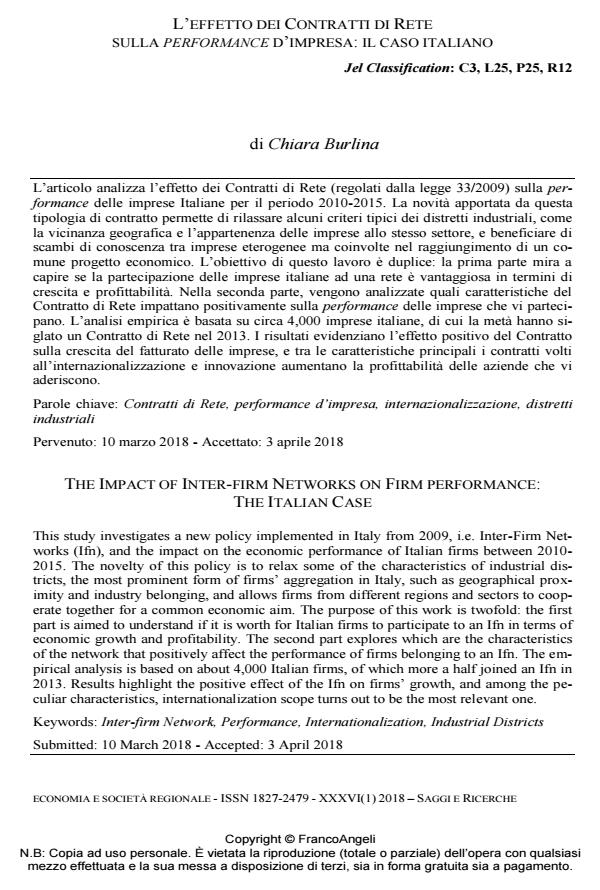The impact of inter-firm networks on firm performance: the italian case
Journal title ECONOMIA E SOCIETÀ REGIONALE
Author/s Chiara Burlina
Publishing Year 2018 Issue 2018/1
Language Italian Pages 15 P. 138-152 File size 320 KB
DOI 10.3280/ES2018-001010
DOI is like a bar code for intellectual property: to have more infomation
click here
Below, you can see the article first page
If you want to buy this article in PDF format, you can do it, following the instructions to buy download credits

FrancoAngeli is member of Publishers International Linking Association, Inc (PILA), a not-for-profit association which run the CrossRef service enabling links to and from online scholarly content.
This study investigates a new policy implemented in Italy from 2009, i.e. Inter-Firm Networks (Ifn), and the impact on the economic performance of Italian firms between 2010-2015. The novelty of this policy is to relax some of the characteristics of industrial districts, the most prominent form of firms’ aggregation in Italy, such as geographical proximity and industry belonging, and allows firms from different regions and sectors to cooperate together for a common economic aim. The purpose of this work is twofold: the first part is aimed to understand if it is worth for Italian firms to participate to an Ifn in terms of economic growth and profitability. The second part explores which are the characteristics of the network that positively affect the performance of firms belonging to an Ifn. The empirical analysis is based on about 4,000 Italian firms, of which more a half joined an Ifn in 2013. Results highlight the positive effect of the Ifn on firms’ growth, and among the peculiar characteristics, internationalization scope turns out to be the most relevant one.
Keywords: Inter-firm Network, Performance, Internationalization, Industrial Districts
Jel codes: C3, L25, P25, R12
- Thorelli H.B. (1986). Networks: Between Markets and Hierarchies. Strategic Management Journal, 7(1): 37-51, DOI: 10.2307/248596
- Álavarez L., Marin R., Fonfría A. (2009). The Role of Networking in the Competitiveness of Firm. Technological Forecasting and Social Change, 76(3): 410-421,
- Balland P.A., De Vaan M., Boschma R. (2013). The Dynamics of Interfirm Networks along the Industry Life Cycle: The Case of the Global Video Game Industry, 1987-2007. Journal of Economic Geography, 13(5): 741-765,
- Williamson O.E. (1991). Comparative Economic Organization: The Analysis of Discrete Structural Alternatives. Administrative Science Quarterly, 36(2): 269-296, DOI: 10.2307/2393356
- Baudry B., Chassagnon V. (2012). The Vertical Network Organization as a Specific Governance Structure: What are the Challenges for Incomplete Contracts Theories and what are the Theoretical Implications for the Boundaries of the (Hub-) Firm?. Journal of Management & Governance, 16(2): 285-303,
- Cartocci R. (2007). Mappe del tesoro. Atlante del capitale sociale in Italia. Bologna: il Mulino.
- Coase R.H. (1937). The Nature of the Firm. Economica, 4(16): 386-405,
- De Marchi V., Grandinetti R. (2014). Industrial Districts and the Collapse of the Marshallian Model: Looking at the Italian Experience. Competition and Change, 18(1): 70-87, DOI: 10.1179/1024529413Z.00000000049
- Grandori A., Soda G. (1995). Inter-firm Networks: Antecedents, Mechanisms and Forms. Organization Studies, 16(2): 183-214, DOI: 10.1177/017084069501600201
- Guiso L., Sapienza P., Zingales L. (2004). The Role of Social Capital in Financial Development. American Economic Review, 94(3): 526-556, DOI: 10.1257/0002828041464498
- Hakansson H., Lind J. (2004). Accounting and Network Coordination. Accounting, Organizations and Society, 29(1): 51-72, DOI: 10.1016/S0361-3682(02)00058-2
- Hodgson G.M. (2002). The Legal Nature of the Firm and the Myth of the Firm-Market Hybrid. International Journal of the Economics of Business, 9(1): 37-60, DOI: 10.1080/13571510110102967
- Inkpen A.C, Tsang E.W.K. (2005). Social Capital, Networks, and Knowledge Transfer. The Academy of Management Review, 30(1): 146–165, DOI: 10.2307/20159100
- Istat (2015). I distretti Industriali. Statistiche Report -- <https://www.istat.it/it/files/2015/02/Distretti-industriali.pdf?title=I+distretti+industriali+-+24%2Ffeb%2F2015+-+Testo+integrale.pdf (Accessed: 29 March 2018).>
- Istat, Cdc, Retimprese (2017). Reti d’Impresa. Gli effetti del contratto di Rete sulla performance delle imprese -- <http://www.istat.it/it/files/2017/11/Rapporto_Istat_Confindustria.pdf?title=Reti+d’impresa++-+20%2Fnov%2F2017+-+Volume.pdf.>
- Lechner C., Dowling M. (2003). Firm Networks: External Relationships as Sources for the Growth and Competitiveness of Entrepreneurial Firms. Entrepreneurship & Regional Development, 15(1): 1-26, DOI: 10.1080/08985620210159220
- Ménard C. (1995). Markets as Institutions versus Organizations as Markets? Disentangling some Fundamental Concepts. Journal of Economic Behavior
- & Organization, 28(2): 161-182,
- Managerial and Decision Economics, 34(3-5): 124-139,
- Mowery D.C., Oxley J.E., Silverman B.S. (1996). Strategic Alliances and Interfirm Knowledge Transfer. Strategic Management Journal, 17(S2): 77-91,
- Negrelli S., Pacetti V. (2016). I Contratti di Rete. Pratiche di capitale sociale tra le imprese Italiane. Bologna: il Mulino.
- Paniccia I. (1998). One, a Hundred, Thousands of Industrial Districts. Organizational Variety in Local Networks of Small and Medium-sized Enterprises. Organization Studies, 19(4): 667-699, DOI: 10.1177/017084069801900406
- Pavitt K. (1984). Sectoral Patterns of Technical Change: Towards a Taxonomy and a Theory. Research Policy, 13(6): 343-373, DOI: 10.1016/0048-7333(84)90018-0
- Powell W.W. (1990). Neither Market nor Hierarchy: Network Forms of Organization. Research in Organizational Behaviour, 12: 295-336.
- Stuart T.E. (2000). Interorganizational Alliances and the Performance of Firms: A Study of Growth and Innovation Rates in a High-Technology Industry. Strategic Management Journal, 21(8): 791-811, DOI: 10.2307/3094397
- Zenger T.R. (2002). Crafting Internal Hybrids: Complementarities, Common Change Initiatives, and the Team-Based Organization. International Journal of the Economics of Business, 9(1): 79-95, DOI: 10.1080/13571510110102985
- Zucchella A. (2006). Local Cluster Dynamics: Trajectories of Mature Industrial Districts between Decline and Multiple Embeddedness. Journal of Institutional Economics, 2(1): 21-44,
Chiara Burlina, L’effetto dei contratti di rete sulla performance d’impresa: il caso italiano in "ECONOMIA E SOCIETÀ REGIONALE " 1/2018, pp 138-152, DOI: 10.3280/ES2018-001010